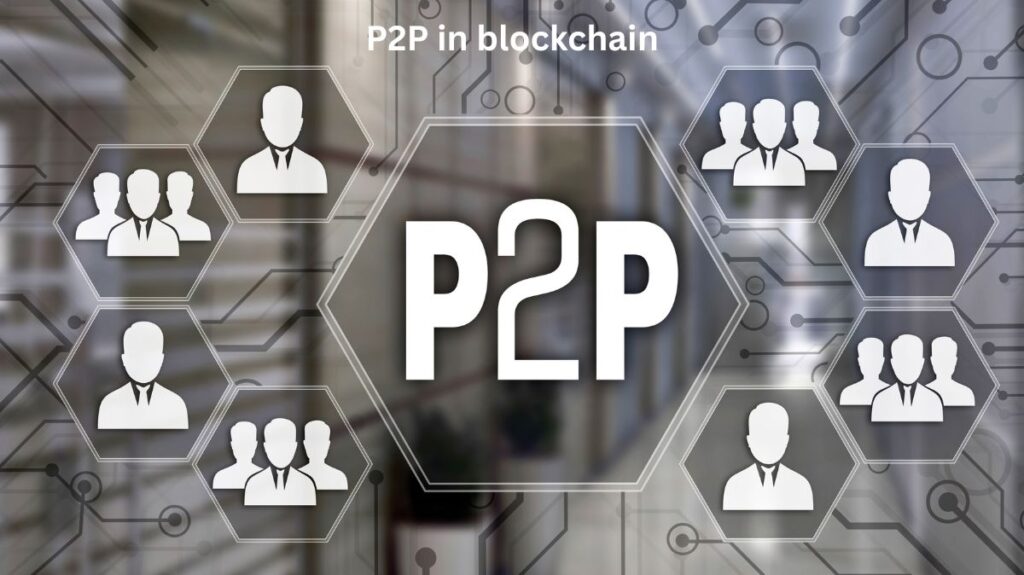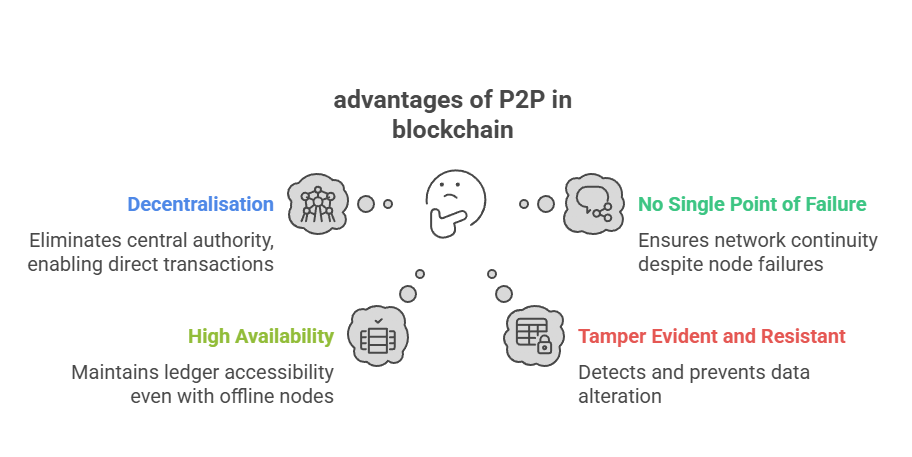What is P2P in blockchain?

Nodes can directly communicate in P2P networks. No central server or authority connects peer-to-peer networks. Instead of using a central server, P2P nodes interact directly. Fundamentally, a peer-to-peer(P2P) network is a network setup in which two or more computers often referred to as peers or nodes can speak with one another directly. In contrast to conventional client-server systems, the system as a whole does not rely on a single server or authority for data sharing or communication. Every peer or node in a P2P system typically has the same privileges.
Centralized systems, which usually entail a client sending requests to a central server that serves as a middleman, stand in stark contrast to this architecture. In a centralized system, requests from two clients are sent through the server if they need to communicate. Centralized systems rely on a single source of service, which creates a single point of failure, even though they function well for many applications (such as the current internet’s Web 2.0, which is exemplified by social networks or search engines).
Even when data and computation are dispersed among several nodes, distributed systems can still be managed by a single individual. However, a P2P network is an essential feature of decentralized systems, in which many people share the decision-making authority.
P2P networking gained popularity in the past because to file-sharing apps like BitTorrent, which showed how each node could function as both a client and a server. Parts of files lived on multiple computers and were peer-to-peer accessible; no single computer controlled an entire file.
Also Read About What Are Smart Contract Challenges, Features & Developments
Key Features of P2P
P2P’s salient features and attributes include:
Direct Communication
Participants have direct conversations with one another. This makes it possible for peer-to-peer transactions to take place directly without the need for a bank or other third party to get involved.
Distributed Nature
One type of distributed system is peer-to-peer networks. Calculation and accountability are dispersed among numerous computers rather than being handled by a single computer.
Equal Standing
In a P2P network, nodes frequently share equal rights and obligations when it comes to data processing. It is possible for any node to serve as both a client and a server.
Robustness and Fault Tolerance
P2P architecture’s robustness is a key benefit. The system as a whole does not necessarily fail or crash when one node, or even several nodes, fail. Because it is spread, it is challenging for anyone to take down the network.
Relation to DLT and Blockchain
P2P underpins blockchain and DLT. Blockchain tracks transactions peer-to-peer. Bitcoin blockchain is a peer-to-peer cash system.
Blockchain mechanism
- P2P networks are necessary for the blockchain to function. For example:
- A node’s started transactions are broadcast (propagated) to other nodes via the P2P network.
- Nodes automatically synchronize with other peers and keep copies of the shared ledger.
- Consensus procedures frequently depend on peer participants’ agreement and communication.
- Peer-to-peer communication is used for file sharing, DHT distribution, and encrypted chat.
- Alternative to Centralized Systems: P2P networking offers improvements such improved privacy and no middleman commission or central authority.
Also Read About What Are The Blockchain Transaction Steps And Types?
Communication Methods
P2P networks communicate using a variety of protocols:
- Protocols for gossip: Used to spread information around a network.
- Nodes exchange messages with one another in order to communicate.
- Point-to-Point Communication: In systems such as R3 Corda, direct communication occurs between designated nodes.
- Specific protocol suites for node discovery and safe communication, such as Ethereum’s RLPx/DevP2P.
Bitcoin, BitTorrent, IPFS (InterPlanetary File System), R3 Corda, OpenBazaar (a peer-to-peer marketplace), and Ethereum’s Whisper messaging protocol are a few examples of P2P systems or technologies that were discussed. Aries is defined as a P2P infrastructure with a blockchain foundation.
Role of P2P in Blockchain
The foundation of blockchain technology is a peer-to-peer system. In the same way that protocols like HTTP or SMTP operate on TCP/IP, the blockchain itself may be thought of as a layer operating on top of a distributed peer-to-peer network.
Within a network of blockchains:
- Peers are Nodes: The computers or systems that are part of the network are called peers or nodes. A complete node is frequently maintained by each member.
- Direct Communication: Using the particular blockchain protocol, nodes communicate directly with one another.
- Transaction Broadcasting: A transaction that is started by a user and signed with their private key is broadcast to all nodes connected to the network. This is accomplished through the use of information dissemination techniques like floods and gossip.
- Distributed Ledger: In a P2P network, every node usually keeps an exact duplicate of the entire ledger.This ledger is shared by all nodes, even non-transaction participants, for transparency.
- The blockchain’s consensus mechanism relies on its P2P topology. New blocks and transaction legality are decided by all nodes. This procedure involves competition or participation from miners or validators (nodes).
Also Read About Consensus Mechanisms In Blockchain: How Networks Agree
P2P advantages in blockchain

The P2P architecture offers a number of significant benefits that support the fundamental characteristics of blockchain:
Decentralisation
Control and decision-making authority are dispersed across network users by doing away with a central server or authority. This eliminates the need for a bank or other reliable third party and enables parties to conduct business directly. Because of this P2P topology, blockchain is frequently referred to as both distributed and decentralised.
No Single Point of Failure
Because the P2P network is spread, the system does not come to a complete stop if one or even several nodes fail. The network can keep working as long as there are enough nodes left in operation.
High Availability
The ledger is still accessible even in the event that some nodes in the P2P network fall offline because the data is duplicated across many nodes.
Tamper Evident and Resistant
Since each node has a copy of the ledger, trying to change data in one copy would cause it to differ from counter-parties’ copies. The network’s consensus mechanism would be able to quickly identify this discrepancy, making it challenging and expensive to implement changes across the majority of the network.
Transparency (in public chains)
Anybody can join a public, permissionless blockchain and frequently see every transaction on the shared ledger. Users may be pseudonymous, with their public key or address serving as their only means of identification, even while the transactions are public.
